The eighth edition of Busworld Turkey (2020) highlighted rising bus and coach electrification.
Story By — Deepti Thore

Opening its doors to the public on March 05, 2020, the eighth edition of Busworld Turkey (2020) attracted 7935 visitors from various parts of the globe. The turnout in this edition as compared to the 2018 edition, which was held at Izmir, was roughly 30 per cent more. Successful in highlighting its international flair against a backdrop of Novel Coronavirus, the biennial fair, held at the Istanbul Expo Center, drew 128 exhibitors. Of these were leading bus and coach builders like Anadolu Isuzu, Karsan and Otokar. If the absence of key players like Temsa and BMC was felt, a large contingent of bus components suppliers found their way to the show as well. They came from various places like China, Germany, Italy, Portugal, Spain, Sweden and Taiwan.
While the key global aggregate suppliers that participated were Cummins, Allison Transmission and Voith, the long list of homegrown suppliers included companies like Makro Tekstil, GRL A.S., Inova Otomotiv, Dora Otomotive, Global Gas Springs, Hafex Aerosol Systems, Pinel Otomotiv, Mutlu Aku, Agyersan, General Teknik, MRC Otomotiv, Oto Numune, and Engin Oto. Highlighting Turkey’s status as the leading bus industry destination in Europe, these suppliers also put the spotlight on Turkey’s culture of modern manufacture and innovation that is growing in the country. If the larger turnout of electronic components suppliers hinted at the change, the nature of the buses and coaches displayed at the fair pointed at a rising shift towards electrification.
With zero emissions on the agenda, Busworld Turkey 2020, highlighted a significant shift at the supplier as well as at the bus and coach manufacturing level. Over 35 vehicles were displayed. These came in various types and guises; in various forms to support a sustainable and efficient transportation ecosystem. Stressing on how advanced the Turkish bus and coach industry is, and how it is transforming, the fair, expressed Vincent Dewaele, CEO, Busworld International, was worthy of being described as the second biggest exhibition in their portfolio. Busworld International’s first exhibition in the current calendar year, Busworld Turkey (2020) occupied a space of 6868 sq. m.
Spread across two of the 11 exhibition halls the Istanbul Expo Center has to offer, the expo turned out to be quite effective. Providing a platform to the stakeholders of the international bus and coach industry to conduct business, the fair highlighted a distinct shift taking place in the Turkish market as well as the European and Asian markets surrounding it. Mentioned Fatih Tamay, Head, International Passenger Transport Union (IPRU), in his inaugural speech, “Smart mobility, electric vehicles, autonomous vehicles, artificial intelligence, carbon footprint, smart navigations system, smart payments systems, accessibility, safety, smart lighting, smart air-conditioning and information sharing will form an important part of sustainable people mobility in the future.” He stressed on smart cities deploying electric buses for public transport.

Announcing that his association is taking steps to usher new buses in a bid to improve people’s mobility in Turkey, Ercan Soydaş, Chairman, TOHOB, averred that his country is a major exporter of buses and coaches. It is supported by a strong manufacturing base, he added. The strength of Turkey’s manufacturing industry was aptly highlighted through the conferences the Busworld Academy conducted simultaneously. While the rides arranged by Karsan in its Jest 100 per cent electric bus added to the premise, the views and information exchanged by industry stakeholders at the conferences highlighted the significant shift taking place at various levels. Said Mustafa Yıldırım, Chairman of the Turkish Road Transport Sector Council, in his speech at one of the conferences, that there was a need to innovate; to deploy innovative technologies for zero-emission bus services in cities as an effort to improve quality of life. Of much interest turned out to be the conference on the bus and coach market in Turkey with Debashish Bhattacharjee, Human Settlements Officer (water and sanitation), UN-HABITAT, Choudhury Rudra Charan Mohanty, Environment Programme Coordinator, UNCRD, and Mohamed Saadieh, President, UCLG-MEWA, as the participants.
If the conference on the bus and coach market in Turkey drew a comparison with East European and West Asian markets in terms of the implementation of future-oriented bus systems, the conference organised by UCLG-MEWA stressed on urban mobility and how it could be of advantage to the local governments. Sergio Avelleda, Director, World Resource Institute, a global research organisation working on six critical goals that the world must achieve in this decade to secure a sustainable future, spoke about the barriers that are making it challenging to adopt e-buses. He spoke about a strategy to deal with the challenges as well.
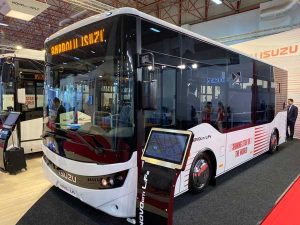
Anadolu Isuzu
Presenting a slew of eco-friendly buses in the form of the Citiport 12 CNG, Novociti Life, Novociti Volt (Electric), and Novo Lux, Anadolu Isuzu highlighted a shift towards electrification and alternate fuels. Pointing at the bus and coach builder’s presence in respective bus segments in Turkey with EuroVI Phase D in force, the buses underlined the company’s position as a leading exporter of midi-buses for the last 15 years as well.
Claimed to develop vehicles for European municipalities with a local content of 70 per cent, Anadolu Isuzu displayed the NovoCiti Life, which is said to be the most sought after diesel bus in Europe. It measures eight-metres and is the winner of three awards in Turkey, Poland and Italy each, according to Anadolu Isuzu sources. A low-floor design, the bus is positioned such that it falls between the 9.5 m Citibus and the 7.5 m Novociti. It is targeted at cities with narrow streets and is designed to support the integration of people with disabilities and the elderly. Creating a new segment thus, with a smaller dimension to boast of, the bus is powered by a 186 hp FPT 4.5-litre NEF4 engine. Using non-EGR technology that enables it to be highly efficient and consume less fuel. Equipped with the pneumatic suspension at the front and rear, it can accommodate up to 60 commuters (21 seated and 39 standing).
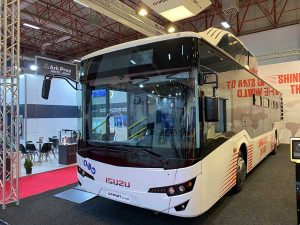
As an electric version of NovoCiti Life, the NovoCiti Volt (shown last year at Busworld Europa) is electric in nature. It is equipped with a 240 kW electric motor situated at the rear and supports the near-silent operation. Available with two different battery packs (the 140 kWh version delivers a range of up to 210 km and the 268 kWh version offers a range of upto 400 km) that are placed on the roof, the bus is fitted with an AVAS (Acoustic Vehicle Alerting System). AVAS generates an artificial engine sound for pedestrian safety. Charged from a single charging socket (AC at 22 kW or DC at 140 kW), the battery life of the bus is guaranteed to not decrease below 70 per cent for five years or 250,000 km. Capable of quick charging in two hours with 600-Volt operating voltage, the batteries could be charged via a home charge (AC in eight hours) either.
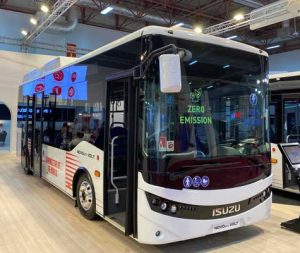
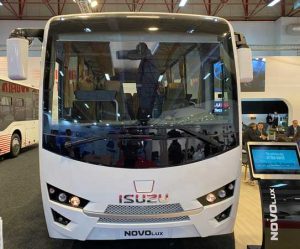 With a focus on curbing emissions, the CNG-powered Citiport 12 is powered by a 300 hp Cummins engine mated to a ZF Ecolife auto transmission. Measuring 12 m in length, the low-floor bus offers a smooth driving experience. The interior layout is spacious, and the vehicle comes with a kneeling system for disabled-friendly operation. Offering a barrier-free journey for all passengers, the bus is equipped with EBS, ABS, ASR, integrated retarder, hill holder, independent air suspension and an integrated CCTV system. The dashboard is ergonomically designed, and the driver seat is heated. There’s a digital air-con as well as a passenger counting system. Delivering a comfortable ride, the 7.3 m long Novo Lux is a mid-size coach for an application like a personnel shuttle or as a bus that ferries tourists. Could be had with a 2×1 seating layout, it is powered by a 190 hp 5.1-litre diesel engine mated to a six-speed gearbox. The suspension is made up of parabolic leaf springs at the front and rear. There is a choice of pneumatic suspension at the rear.
With a focus on curbing emissions, the CNG-powered Citiport 12 is powered by a 300 hp Cummins engine mated to a ZF Ecolife auto transmission. Measuring 12 m in length, the low-floor bus offers a smooth driving experience. The interior layout is spacious, and the vehicle comes with a kneeling system for disabled-friendly operation. Offering a barrier-free journey for all passengers, the bus is equipped with EBS, ABS, ASR, integrated retarder, hill holder, independent air suspension and an integrated CCTV system. The dashboard is ergonomically designed, and the driver seat is heated. There’s a digital air-con as well as a passenger counting system. Delivering a comfortable ride, the 7.3 m long Novo Lux is a mid-size coach for an application like a personnel shuttle or as a bus that ferries tourists. Could be had with a 2×1 seating layout, it is powered by a 190 hp 5.1-litre diesel engine mated to a six-speed gearbox. The suspension is made up of parabolic leaf springs at the front and rear. There is a choice of pneumatic suspension at the rear.

Otokar
Of the five buses that Otokar displayed, it was the Kent Electra that drew the most attention. Leveraging Otokar’s experience in building some of the best and most regarded buses, the Kent Electra measures 12 m in length. A flagship offering of the company, it is backed by its manufacturer’s ambition to become a global brand. Capable of carrying up to 95 passengers (29 seated and 65 standing), the bus is fitted with a ZF AVE 130 electric portal axle. It produces a maximum power of 250 kW and contains four packs of seven Lithium-Ion batteries amounting to 350 kWh capacity. Available with two or three doors as per the application, the bus features independent front wheel suspension and active safety technologies like ABS, EBS and ASR. Fully charged in four hours through depot charging, the bus, without the need of any infrastructure along the route, can run for up to 300 km.
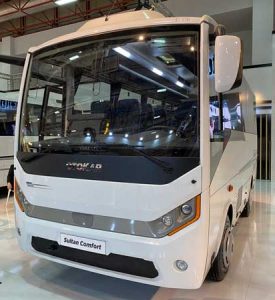
Reflecting Otokar’s innovative design philosophy, the Sultan LF is a low-floor design bus measuring 8.3 m in length. It has a passenger capacity of up to 63 people (21 seating and 42 standing). Powered by a 143 hp diesel engine mounted at the front such that it is offset to the near side, allowing for a totally flat floor in the passenger saloon, the bus is a lightweight design. It has a wide front and rear doors. Quite modern and a bit unusual in its appearance as well, the Sultan LF is built with narrow streets in mind. It is aimed at shuttle operators. Worthy of mention is the separate driver’s area.
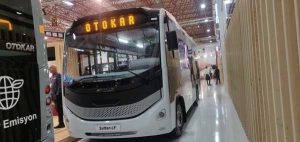
Popular in the Turkish tourist bus market, the Sultan Mega measures 8.5 m in length. It has a total capacity of up to 37 people and is powered by the 173 hp Cummins ISB 4.5 EuroVI diesel engine coupled with an Allison six-speed auto or an Eaton six-speed manual transmission. With ergonomic and functional driver’s area, the bus features the latest security system. It also features LDWS (Lane Breach Warning System), AEBS (Advanced Emergency Braking System), heated horn mirrors, air rear suspension, ABS and ESC braking system.
Capable of accommodating up to 30 people, the Sultan Comfort is 7.2 m long. It is powered by a 143 hp EuroVI diesel engine mated to an Allison T 2100 xFE auto transmission. Aimed at tourism, school and personnel shuttle operations, the bus features Emergency Braking System (AEBS) and front and rear disc brakes. Luxurious in its build, the bus is had with armchairs, armpit refrigerator, announcement system, LCD screen, DVD and a strong air conditioner. About comfort and a silent ride, the Sultan Comfort makes an interesting bus indeed.
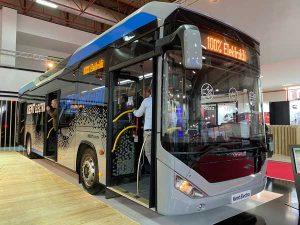
Measuring 10 m in length, the Doruk T can accommodate up to 45 people. It is powered by a 253 hp diesel engine mated to a six-speed Eaton manual transmission. Featuring disc brakes, ABS, EBS and driver-assist technologies, the bus offers high luggage capacity and a spacious interior. With stress on comfort, the Doruk T also features a lane departure warning system (LDWS), advanced AEBS braking system, ASR, and ESP.
Karsan
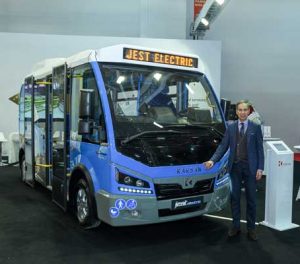
Showcasing its 100 per cent electric public transport vehicles, Jest Electric and AtakElectric, Karsan provided the visitors with an opportunity to experience rising electrification in the Turkish market first hand. Deploying Jest electric buses outside the fair venue for visitors to take a ride, the company highlighted its position as innovative. Measuring six-meter in length, the Jest Electric is a low-floor bus. It is equipped with a BMW electric motor that generates 167 hp of power. Having 44 or 88 kWh batteries, the vehicle is capable of an operating range of 210 km. Featuring regenerative braking at a rate of 25 per cent, the bus could be charged in an hour with fast charging units. It could be charged in eight hours with a 7.4 kW charging option, and with AC charging units. Attractive in appearance, the Jest Electric is highly manoeuvrable and offers a large interior space. Boasting of dynamic design, and unparalleled climbing performance, the bus, capable of operating through narrow city streets, is fitted with 10.1-inch multimedia touchscreen, fully digital dashboard, keyless go, and USB ports as well as an optional WiFi compatible infrastructure. It is equipped with a four-wheel independent suspension system. Capable of accommodating up to 22 commuters (9 seated and 13 standing), the e-bus is already in use in France, Germany and Greece.
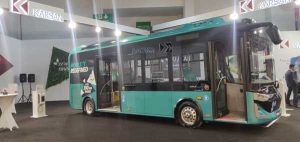
Measuring eight-metre in length, the ATAK Electric midi-bus looks appealing with its LED daytime running lamps. It features a brand-new and dynamic front and rear. Propelled by a 230 kW motor, the bus is supported by five BMW developed 44-kWh batteries. Having an operating range of 300 km, The ATAK Electric could be charged in five hours with AC charging. It could be charged in three hours with a fast-charging unit. The batteries also profit from the regenerative braking system, which recycles power by up to 25 per cent. Capable of accommodating up to 52 passengers with two seating options, the bus has a GVW of 11,000 kg.
Bur-Can
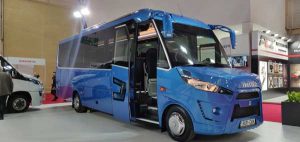
In the business of producing passenger CVs for the last 30 years, Bur-Can displayed some of its most promising low-floor, high-glass buses aimed at tourist, inter-city and intra-city applications. These are made at the company’s modern manufacturing facility at Ankara, which measures 10,000 sq. m. of closed area and 4000 sq. m. of open area. Painted in an attractive shade of blue, a premium tourism bus with a seating capacity of 34 people drew the most attention.
Laced with a disabled ramp with fixed cover, the bus is built on the new Iveco Daily chassis with a GVW of between 3.5-tonnes and seven-tonnes. Flaunting raised front and side windows, route type plastic seats and specially designed front and rear fascia, the bus also profits from the new Daily’s platform length of between 5560 mm and 7500 mm. Boasting of an additional wheel section, the bus has its front console designed to accommodate payment cards such as Kentkart-Akbil. The anti-slip floor of the bus has been reinforced, and the trims made of ABS. If the LED lighting system adds to the pleasant ambience inside, the bus is powered by a choice of 210 hp three-litre or a 156 hp 2.3-litre FIC and FIA engine respectively.
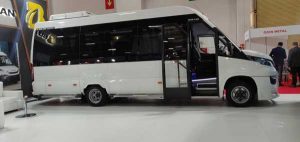
The 18 people or 23 people premium tourism bus is equipped with a special design tribune ceiling. It flaunts a single front wing door system and is fitted with luxurious and comfortable seats. The seating arrangement is 2×1. Also fitted with a USB adaptable TV and android double radio, the bus could be had with a powerful air conditioner. A Webasto passenger heating system is also on offer.
Far removed from the luxury angle highlighted by the blue and the other premium tourist bus, the public bus on the Iveco Daily chassis can seat 22 people. It is equipped with a hidden disability lift system for disabled access and has line-type comfortable seats. The front and side windows are raised, and the tailgate is specially designed. Other features include a rear parking sensor, analog and split air-con and an additional passenger compartment fan heater. The internal LED lighting systems make the interior appealing.
Mapar
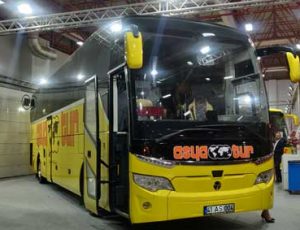
Displaying a refurbished Temsa Safir Plus-Marathon model, two starliner Neoplan bus coaches and a vintage Mercedes Benz Otomarsan bus, Mapar highlighted its penchant for MAN CVs especially. Specialising in servicing as well as refurbishing MAN and Temsa passenger CVs, Mapar operates a gigantic spare parts warehouse in Istanbul. An authorised dealer for MAN Truck and Buses in Bursa and an authorised service outlet for Man Truck and Bus Service at Izmir, Mapar, in the form of the Temsa Safir Plus-Marathon highlighted its ability to service as well as refurbish old and existing CVs. The Safir Plus-Marathon is a modern bus with an aesthetic appearance.
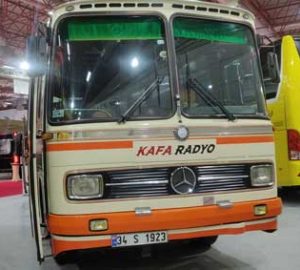
Equipped with advanced technological features such as a driver panel offering assistance for long-distance driving and easy handling, the bus has a seating arrangement of 53 + 1 + 1. It is laced with LCD screens and comfortable and wide leather seats. The Starliner Neoplan bus that Mapar displayed is a flagship product based on a MAN platform at the other end. Completely refurbished by Mapar, it has table sitting and a separate conference-like section with a large LED screen. Flaunting interior LED lights, the bus is fitted with a separate toilet section. It also possesses other amenities that have been designed to address the specific needs of the travellers.
CanCan
CanCan displayed two city buses and one tourist bus built on a MAN and Mercedes-Benz Sprinter chassis. Highly customised, these vehicles are typically urban in their orientation. They highlighted the company’s endeavour to expand its reach in the European market. Targeting the production of more electric vehicles in the next two years, CanCan specialises in the design of ‘VIP’ vehicles and vehicles for disabled people. The company also specialises in auto upholstery, auto accessories and the building of public and corporate vehicles. CanCan is also a group partner (VAN-Partner) to many global brands like Mercedes-Benz.

Minabus
Established in Istanbul, Minabus specialises in the designing of passenger commercial vehicle interiors. The company caters to city bus, intercity buses, tourist bus, luxury minibus and disabled-friendly bus segments. Displaying a line van built on Volkswagen Crafter chassis, and a tourism and school bus built on a Mercedes-Benz Sprinter chassis, Minabus highlighted its area of work like interior lighting systems, glasses, etc.

Produced in accordance with the customer demand for urban transportation, the Line vans that Minabus builds, feature electric outward opening door systems with a cam, M2 certified seat belt seats (three-point), heating systems, and monoblock air conditioners. Aesthetically well-sorted, the vans are had with interior lighting, floor covering and a luggage rack that is fairly customised to the taste of the operator and end-users. Equipped with sliding doors or electric outward opening doors with an automatic step for diverse application areas, the Line vans from Minabus make
for interesting design elements, which range from modest to sporty to premium. The interiors are suitably dressed and make for an interesting statement when it comes to addressing different tastes.
Erduman

A pioneer in the bodybuilding sector, the company displayed a midi- and mini-bus built on a Mercedes-Benz and Iveco chassis. The company also displayed a VIP sprinter chassis and a Mercedes-Benz tourer bus with a capacity to accommodate up to 39 people. Powered by a four- or six-cylinder diesel engine, the tourer bus is uniquely designed to offer superior passenger comfort. The bus could be had with an electrical lift solution. Said a source close to the company, that they also offer low floor solutions on chassis of other makes, including DAF.
UĞur Karoser

Known to provide minibus conversions and vehicles, Uğur Karoser displayed a minibus each on Mercedes-Benz and Iveco chassis. With a focus on European markets, the company is producing vehicles that are compatible with technologies that find use in public transportation. The company also produces its own midi-buses on the Iveco chassis. With bodybuilding and modification of buses and minibuses as their main activity, Uğur Karoser offers its own-built midi-buses on the Iveco Daily chassis for tourism, school bus and low-floor applications. The Mercedes-Benz Sprinter-based buses they build, find a use for tourism, city bus and low-floor applications.



















